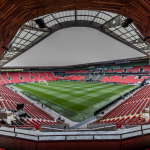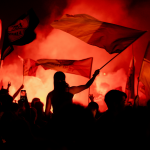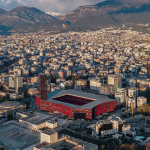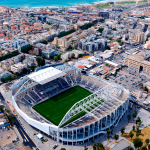
History of Molten and World Cup and Olympic footballs
The Japanese brand also produces Europa League and Conference League balls
June 1st, 2023
There is an era of football that we are inclined to look at with respect to the history of the game, as we look at prehistory with respect to the evolution of man. The football of the late 19th century and up to the 1920s is too far removed from today's, both in terms of what it represented and the style of uniforms and equipment. There is a passage, related precisely to equipment, that I have always thought marked the entry into modernity and it is the entry in 1931 of the Superball, invented by Italian immigrants in Argentina and which put aside that model with its irregular shape and thick seams that were impractical - as well as safe. Since then, the focus on balls has been increasing, with companies specializing in the production of ever lighter, higher-performance models designed to improve the game, including Molten. The Japanese company is one of the largest in the world to produce balls, which you will have used or seen during volleyball, football, handball and especially basketball matches.
Surely you have seen a Molten ball if you followed the Europa League Final between Roma and Sevilla. The one kicked by Montiel for the last penalty of the match, and all the others used this year are in fact produced by the Japanese brand, which for years has accompanied the great feats of sport and the successes of the major European football tournaments, including the Conference League.
Founded in 1958 by Kiyoshi Nobori in Nakahiromachi, Nishi-ku, in Hiroshima Prefecture in Japan, Molten put its first ball on the market the following year and within two years had a contract of collaboration with the national volleyball, basketball and handball federations. These were the three sports in which Molten was still most present, but in 1973 the brand became a ball supplier for FIFA and in 1978 it produced, together with adidas, one of the most famous and cult balls for nostalgia football fans, the Tango. For more than a decade, Molten had already entered the circuit of the world's major sporting events. In 1964, its balls were used during the Tokyo Olympics, and this will also be the case for all games from '84 to 2016, with the Japanese company supplying balls for basketball tournaments. Molten's Olympic history is inevitably intertwined with great teams and victories, such as the legendary Dream Team USA in 1992 or Italy's silver medal in Athens 2004.
Molten continued to produce balls over the years, including adidas' Teamgeist, which was to change the brand's aesthetics for years, influencing football in the early 2000s. In the meantime, Molten Corporation also continued with production in fields far from sports, particularly in the healthcare sector, for which it produces orthopedic objects, mattresses and other support and protection items for the elderly. The automotive sector has also been a focus for the company for years, both with the sponsorship of the Hiroshima Mazda Racing Team that races in the Pirelli Super Taikyu Series, and the production of gears and seals. The years of experience and study of materials such as rubber and resin mean that various companies use Molten's technical expertise, which in the meantime also continue to make balls for major international sporting events.
Next 31 May, when Roma and Sevilla will play each other in Budapest for the Europa League final, the referee will bring the Molten Vantaggio 5000 model to the centre of the pitch, and the same thing will happen for the Conference League final between Fiorentina and West Ham. The ball used for the two events is in fact produced by the Japanese company, a collaboration that started with the 2018/2019 edition. We often only talk about balls when they represent the symbol of great competitions, as in the case of the World Cup, but innovation is continuous and in the case of Molten it is the result of almost a hundred years of history and technology applied to sport.























